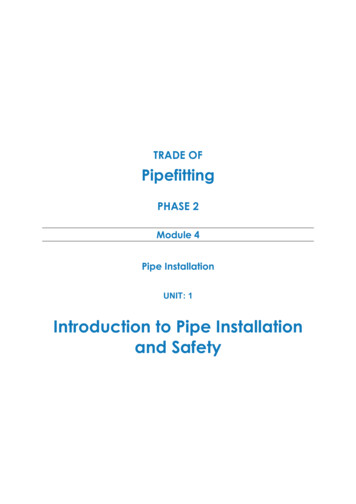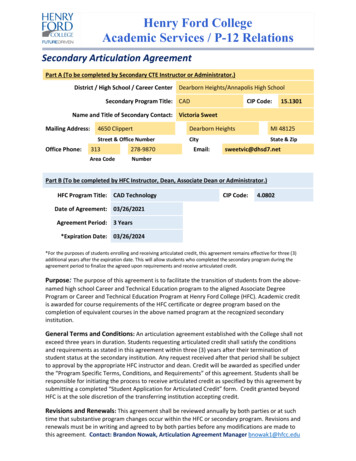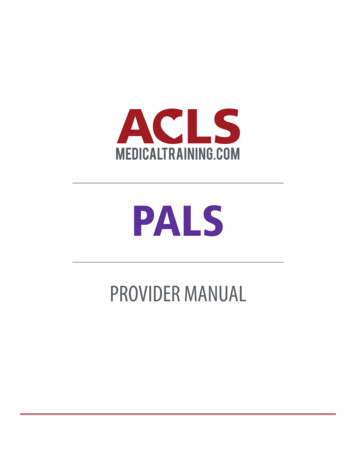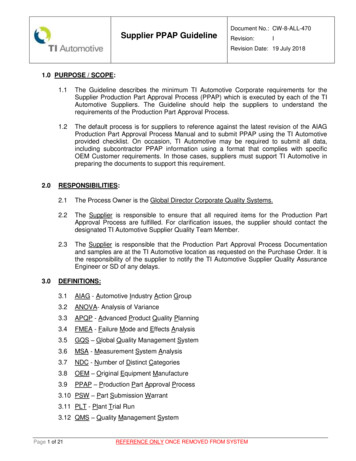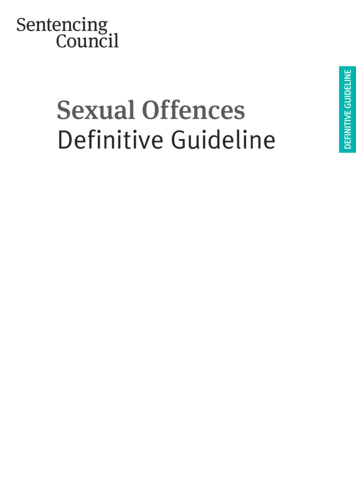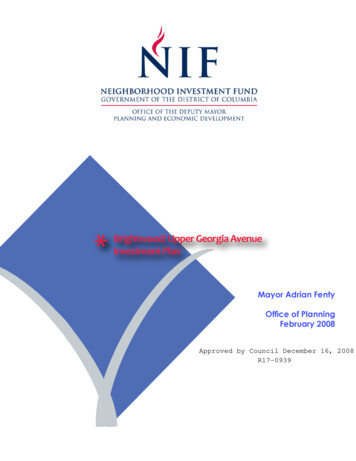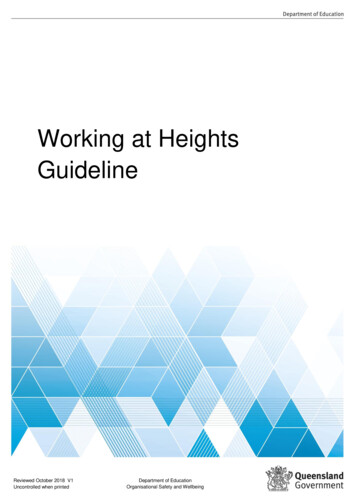
Transcription
Working at HeightsGuidelineJune 2014Reviewed October 2018 V1Uncontrolled when printedDepartment of EducationOrganisational Safety and Wellbeing
Contents1.Purpose32.Legislation33.Construction work34.What do I have to do to manage fall from heights 1.2Contracting out the task6Managing contractors6Employees86.Controlling the risk when working at heights97.Using and maintaining the right equipment118.Monitor/Review Controls119.Record Keeping1110. Training1211. Specialised training and licensing1212. Useful references1313. Definitions13Appendix 1: A basic process for managing work at heights14Appendix 2: Selection of equipment linked to the 5 level hierarchy of fall control.15Department of Education Working at heights supporting documents Working at heights inspection gies/Documents/working-heights-inspectiontool.DOCX Working at heights risk assessment template.DOCX Safe Work Method Statement (SWMS) rategies/Documents/safe-work-methodtemplate.DOCX Creating Healthier Workplaces - Working at Heights- including a range of zardsReviewed October 2018 V1Uncontrolled when printedDepartment of EducationOrganisational Safety and Wellbeing
Working at Heights1. PurposeThis guideline is about managing fall hazards. A fall hazard is: a situation where a person is exposed to a risk of a fall from one level to another that is reasonablylikely to cause an injury. Even falls from a low height have the potential to cause serious injury andmust be managed.a falling object. These can cause serious injuries if controls are not implemented to eliminate orminimise the associated risks. A person can receive fatal head injuries if an unsecured object isdropped from a height. It is essential to ensure that objects do not fall onto people who may be underor next to the area where the work is being carried out.This Guideline provides information to assist workplaces to manage fall hazards in the workplace whichincludes activities where people are working: off the ground (e.g. up ladders, on work platforms)on the ground close to holes (e.g. excavations) edges or ledges (e.g. retaining walls)openings through which people could fall (e.g. skylight) orin areas where objects may fall from higher levels and cause injury.2. LegislationPart 4.4 of the Work Health and Safety Regulation 2011 (Qld) has specific requirements regarding themanagement of fall hazards. These requirements must be implemented by workplaces.The Regulation does not differentiate between height distances (R78). Requirements apply to all fallhazards from one level to another, regardless of the distance from the ground, including the use oflow level platforms and ladders.The Regulation provides a five level hierarchy of control that stipulates the options to manage fall hazards(R79).The hierarchy begins with the level 1 control elimination - the most effective hazard control strategy. A lowerorder control (e.g. level 4 or 5) can only be used when it is not reasonably practicable to use a higher one.The fall from heights hierarchy of control is:Level 1:Eliminate the hazard by performing the work on the ground or on a solid construction.Level 2:Use a passive fall prevention device; e.g. edge protection which prevents falls.Level 3: Use a work positioning system; e.g. which limits movement and therefore minimises access toareas where a fall can occur.Level 4:Use a fall arrest system e.g. a harness, which does not eliminate a fall, it only prevents the personfalling to the ground.Level 5:Use a ladder or implement administrative controls.3. Construction workThere are specific requirements relating to the management of the risk of falls for construction work. Manyactivities undertaken in departmental workplaces can be considered construction work e.g. repairs andmaintenance to structures such as roof gutters.Reviewed October 2018 V1Uncontrolled when printedDepartment of EducationOrganisational Safety and Wellbeing
This Work at Heights Guideline and companion Work at Heights Risk Assessment Template will assistto fulfill the legislative requirements for managing falls in relation to construction work. Workers andcontractors are required to supply a Safe Work Method Statement (SWMS) or equivalent for work over 2metres above the ground (measured from the feet) or 1.5 metres below a surface (R299).4. What do I have to do to manage fall from heights risks?To manage the risk of falls, you are required to follow the hierarchy of controls for work at height as follows:1. avoid the risk by not working at height (e.g. work from an existing platform, use extendable equipmentetc.). If it is not practicable to do the work safely in some other way then:2. use work equipment or other measures to prevent falls (i.e. isolate worker from a fall); or3. where the risk of a fall cannot be eliminated, use further controls to minimise the distance andconsequences of a fall should one occur.Remember that minimisation is only acceptable when you have exhaustedelimination and isolation. Doing nothing is not an option.The legislation does not specifically require a written risk assessment to manage falls if you already knowthe risks and know how to control them.To achieve the intent of the regulation, DoE requires all staff to document their risk management practices inthe following ways for all activities which have the potential for falls from height:Work at Heights TaskRequired ActionsAny activity that involves beingon, or working on any roof at anystate school facility.Do not proceed. Being on, or working on any roof at anystate school facility is prohibited for all school staff, studentsand visitors.Activities where you already knowthe risks and know how to controlthem.Review and adhere to an existing risk assessment or SafeWork Method Statement (SWMS) or Safe OperatingProcedure (SOP).A new activity or a significant changeto an existing activity that involvesa fall hazard of less than 2 metres.Complete and adhere to a risk assessment.Apply the hierarchy of control starting at level 1 (elimination).If ladders are used, you must state why you are not using ahigher level control.Tasks that involve fall hazards of 2metres or more above the ground(measured from the feet).ORComplete and adhere to a Safe Work Method Statement(SWMS)Develop and adhere to any SOPs relevant to the safecompletion of the task e.g. for plant and equipment, pre-startprocedures.Tasks that involve fall hazards of 1.5metres below ground level(measured from the feet).Reviewed October 2018 V1Uncontrolled when printedDepartment of EducationOrganisational Safety and Wellbeing
If you have a number of different work areas or activities and the fall hazards are the same, you mayperform a single (or generic) risk assessment. However, you should carry out a risk assessment onindividual fall hazards if there is any likelihood that a person may be exposed to greater, additional ordifferent risks.A SWMS must break down the job into a series of ”step by step” tasks to ensure the hazards areidentified for each step and controls are implemented to control the risks associated with each step.It is important that tasks are monitored and reviewed and any changes (e.g. improved controlmeasures) are documented on the risk assessment/SOP/SWMS and communicated to staff for the nexttime the task is undertaken.The Principal/Manager of the workplace must ensure that the specific safe work procedures are documentedand implemented before the proposed work commences.Further information to assist you with risk management for working at heights can be found in the documentWorking at Heights Inspection Tool and in Section 12 of this document.5. Responsibilities5.1 Principal/ManagersThe following outlines the responsibilities of the person in charge of workplaces.School principals are reminded that there is a prohibition on DoE staff, students and volunteers beingon, or working on any roof at any state school facility.This prohibition includes all roofs on buildings, structures and covered walkways e.g. single andmulti-storey structures, breezeway roofs, awnings, shed roofs, detached or demountable buildingsroofs, sun shade structures etc.1. Implement a risk management process to address fall hazards. The Working at Height Risk Assessment template and Safe Work Method Statement templatehave been developed to assist workplaces complete this risk management process. Identify the fall hazards associated with tasks and locations that place staff, students or others atrisk of injury. The Working at Heights Inspection Tool may help you with this process. Assess the risks associated with the identified hazards i.e. what is the likelihood that a seriousinjury will result if there was a fall? Control the risk of falls so far as is reasonably practicable by following the five-level hierarchy ofcontrols for preventing falls from heights (see Section 2).oProvide those who are working at height with adequate information, training and instructionin relation to preventing and managing fall hazards, including the use of equipment.oEnsure control measures are fit for purpose, suitable for the nature or duration of the work,installed and used correctly and maintained in good working order.oEnsure systems are in place for contractors – see more information below Review and monitor the work at height practices and revise risk control measures or systems ofwork where necessary.Reviewed October 2018 V1Uncontrolled when printedDepartment of EducationOrganisational Safety and Wellbeing
2. Maintain records of fall hazards, risk assessments, safe work procedures and training.The basic process for managing working at heights is summarised in Appendix 1. Appendix 2provides guidance on the selection of suitable equipment linked to the 5 level hierarchy of fallcontrol.Contracting out the taskThere are some working at heights tasks that have a greater inherent risk of serious injury shouldsomething go wrong. These types of activities have the potential for serious injury or fatality shouldcontrols fail. More often than not these tasks require specialised equipment and highly specialisedtraining to complete them safely, and contracting them out is often a cost effective and safer solution.Even if contractors undertake the work, the person in charge of your workplace still has responsibilitiesto manage contractors. Work is to be managed through the Built Environment Materials InformationRegister (BEMIR) and supported by local induction processes whereby contractors are advised ofpotential risks.The types of tasks DoE workplaces might consider contracting out include: 5.1.2Any type of construction work at heights.Roof maintenance/servicing at height e.g. leak repair, storm damage, roof-mounted airconditioning units, air vents and exhaust stacks.Building maintenance/servicing at height e.g. gutter/eaves repair, windows, painting.Work in or near trenches or excavations.Work close to large ‘drops’ such as near retaining walls, natural cliffs e.g. weed control, fencemaintenance.Work on structures being constructed or installed, demolished or dismantled, inspected, tested,repaired or cleaned e.g. tanks, solar panels, drama props.Work areas that have exposed fall hazards during routine maintenance e.g. lift wells, servicepits, tanks (above and below ground), earthworks, manholes, acid and grease traps.Significant tree work e.g. tree pruning, trimming out dead fall/dangerous branches, diseasedwood.Managing contractorsThe Work Health and Safety Act 2011 (Qld) places duties on both the department and the contractor(or the contractor’s employer) to protect the safety of workers and others who undertake work for, orat, departmental workplaces.The department can demonstrate how these duties are met by consistent practices beingimplemented at workplaces. These should focus on consulting with the contractor and documentingthe agreed plans for managing the risks.In practice, the principal or manager can implement this process by:1. Advising the contractor, prior to engagement that the contractor must implement the requirementsof the Work Health and Safety Regulation 2011 (Qld), specifically in relation to managing falls forcontractors, their sub-contractors, employees and others from fall hazards while performing workfor the department. For example, this advice could be provided during the quotation process.2. Providing the contractor with relevant information associated with the proposed work and theworkplace’s expectations including: when the work is to be done (e.g. when least pedestrian traffic is in the area)Reviewed October 2018 V1Uncontrolled when printedDepartment of EducationOrganisational Safety and Wellbeing
where the work is to be done and the potential hazards (e.g. fragile or brittle roofs*, asbestos,electrical hazards, pedestrian traffic; site-specific hazards).* Schools must advise contractors of suspected fragile or brittle roof areas prior to work commencing(e.g. during the quote process) so that specific controls can be incorporated into the contractor’s safework method statement. Examples of fragile or brittle roofs include skylights, rusty metal roofs andpolycarbonate/fibreglass sheet roofs.Note: The removal of all ACM (Asbestos Containing Material) roofs at DoE owned schools was finalisedduring 2007. At other DoE owned workplaces including housing, assumed or confirmed ACM roofing may bepresent. When accessing an assumed/confirmed ACM roof, caution is to be exercised. Aninspection of the area should occur due to potential change of the physical state of the material.3. Ensuring the contractor provides to the Principal/Manager, a risk assessment, safe work methodstatement or equivalent for the work to be performed. This information helps when comparing quotes to ensure the contractor is conducting work incompliance with the Work Health and Safety Regulation 2011 (Qld) and relevant Codes ofPractice. The Principal/Manager will need adequate time to review the information and discuss anyqueries with the contractor. It is reasonable if a principal/manager requires this informationseveral days prior to the proposed commencement of work.4. Reviewing the risk assessment, safe work method statement or equivalent which the contractorshould detail, in a way that the principal/manager understands: the activity’s hazards and risks how work is to be carried out the control measures that will be applied to the work activities to manage the risks the equipment to be used qualifications of the personnel doing the work and how these match to the tasks training or other requirements to undertake the work confirmation that these measures comply with the Work Health and Safety Regulation 2011(Qld) and any relevant Codes of Practice and Australian Standards the way that risks will be monitored and reviewed any strategies that the DoE workplace will need to implement to support the contractor tocomplete the task.5. Consulting with the contractor by: Reviewing the information provided and discuss as required (e.g. the number of contractors onsite for the job - a contractor may be using an individual fall arrest system as part of the workprocedure and, as part of the mandatory emergency plan, has an additional operator on sitethat is appropriately trained in performing a rescue in the case of a fall). Ensuring that all parties agree about the safe system of work to be used to perform work atheight - obtain and record a safe work method statement (SWMS) from the contractor. Determining responsibilities or actions to ensure the work can be conducted as planned. Forexample, the workplace may need to undertake some tasks for the contractor such asestablishing no-go zones, communicating with staff about the dates and times of the work to beundertaken.Reviewed October 2018 V1Uncontrolled when printedDepartment of EducationOrganisational Safety and Wellbeing
6. Issuing a Permit to Work or work area access permit (WAAP) for the contractor.7. Ensure a local ‘induction’ process occurs; i.e. contractors that are on site have been provided withthe SWMS by their employer. Schools are to advise of any new hazards relevant on the day.8. Monitoring work, where practicable, to ensure it aligns with the agreed SWMS/WAAP/Permit toWork. Discuss any problems with, or deviations from, the planned work with the contractor. Document any changes to the SWMS or consultation with contractor.9. Direct work to cease if unsafe or does not comply with SWMS or WAAP/Permit to work.10. Keep a record of how the work was undertaken. e.g. the contractor’s SWMS, the workplace’s WAAP and any amendments made to the plan.5.2 EmployeesWorkers have duties under the Work Health and Safety Act 2011 (Qld) (s28) to take reasonable care oftheir own health and safety and that of others, and to follow reasonable instructions. A worker is to useplant or equipment for the purposes for which it was designed. For example, a chair is designed to sit on, a desk is designed as a working surface; they are notdesigned as a means of accessing a height. At no time is it acceptable for a person to useequipment, such as a piece of furniture that has not been designed for work at heights as a meansof access.The following provides a summary of responsibilities of employees when working at heights: There is a prohibition on DoE staff, students and volunteers being on, or working on roofsat all state school facilities. staff must not climb on inappropriate equipment (e.g. chairs or desks) to reach higher levels. where possible, carry out activities on ground level. receive authorisation from a manager before working at heights where it is determined that work must occur at height, controls are to be determined before heightswork proceeds Refer to Sections 4 and 6 in this document for more specific information. Ensure the person undertaking the task is consulted. Consultation with your local Healthand Safety Advisor (HSA) and line manager may also be needed. assist with the risk assessment process and adhere to any risk management documentation forworking at heights (including risk assessments, SOPs and SWMS) if a cleaner is required to work on a ladder, it is recommended that they work in pairs, with oneclimbing the ladder to complete the cleaning task and the other available to stabilise the ladderand pass materials up and down if there is a risk of fall greater than 2 metres, then a SWMS must be completed and approved. TheSWMS must be adhered to. participate in local workplace heights training relevant to your role. This may include (but notlimited to) safe work at heights induction, hazard identification, ladder safety, undertaking adocumented risk assessment process, developing and applying SWMS and selecting andimplementing control measures. comply with all reasonable instruction in relation to any working at heights procedures report any hazards.Assuming that work at height cannot be avoided, all work needs to be properly planned, organised andmanaged. Workers have a duty to: avoid working at heights wherever they can (eliminate the risk)Reviewed October 2018 V1Uncontrolled when printedDepartment of EducationOrganisational Safety and Wellbeing
use work equipment or other measures to prevent falls where they cannot avoid working atheight (isolate from the hazard) where they cannot eliminate the risk of a fall, use work equipment or other measures to minimisethe distance and consequences of a fall should one occur (minimise) not undertake any hazardous work at heights (e.g. tree lopping, welding).6. Controlling the risk when working at heightsOnce the hazards and risks have been identified, you will need to control them so far as is reasonablypracticable. Appendix 2 provides examples of the selection of equipment linked to the 5 level hierarchy of fallcontrol.The 5 level hierarchy is aimed at: eliminating the working at height hazard (i.e. falls or falling objects – Level 1)isolating people from the working at height hazard (Level 2)minimising the distance and impact of the fall (Levels 3-5).Remember falling objects – if you cannot prevent the object falling,prevent it from hitting someone.6.1 Deciding what level of control to use6.1.1 Level 1 ControlsThe best work methods to control the risks associated with fall hazards are Level 1 controls whicheliminate the hazard altogether. This means that the work is either undertaken from ground level, i.e.the risk of fall from heights is removed altogether, or on a solid construction. A solid construction is a fixed platform, which must comply with AS1657-1992 Fixed Platforms,Walkways, Stairways and Ladders. Solid constructions are categorised as a Level 1 control, as astable platform is seen as equivalent to eliminating the hazard altogether.6.1.2 Level 2 ControlsIf work at heights must be undertaken, the next best work methods are those that don’t require anyconstant judgements by the worker to keep themselves safe, i.e. Level 2 passive fall protectionmeasures. Passive control measures are able to: prevent a fall protect more than one person once properly installed or erected they do not require any action by a person to make sure it willwork have no ongoing costs (such as regular inspections or training requirements).Guard rails and walkways are controls listed in AS1657 and are example of Level 2 controls. Guardrails are considered a ‘passive fall prevention device’ because they isolate the worker from thehazard and are always in place when needed. This makes guardrails the most sustainable permanentsolution for safe maintenance access of all the Level 2 controls, which also includes edge protection,mobile/fixed scaffold, scissor lifts and LiftPods.6.1.3 Level 3 and 4 Controls - to be used by contractors in DoE workplaces rather than by staffLevel 3 ‘work positioning systems’ prevent workers falling over an unprotected edge. They thereforeminimise the height of the hazard and the consequences of a fall. Their effectiveness is reliant onthe competence of the user. Work positioning systems can be used only if Level 1 and 2 passive fallprotection devices are not practicable.Reviewed October 2018 V1Uncontrolled when printedDepartment of EducationOrganisational Safety and Wellbeing
Level 4 ‘fall arrest systems’ (AS1891.4-2009) are designed to minimise injury once a fall has occurredrather than avoiding it in the first place. As a result, the risk of serious injury through the pendulumeffect and suspension trauma is introduced. It is very easy for even well-trained users to makepotentially lethal mistakes.Level 3 and 4 controls require considerable training and are expensive systems to maintain andadminister. In schools these activities are to be undertaken by appropriate contractors as: fall arrest systems, at best, leave a worker hanging in the event of an accident. This means theymust be watched over by a trained supervisor who has a rescue plan in place (R80). users require high skill levels and regular ongoing training and recertification to operate thesedevices. Maintenance and recertification represent considerable ongoing expense. training must be supported by the development of administrative procedures that are subject toconstant review (e.g. rescue plans, SWMS, 6 monthly equipment inspections (AS1891),maintenance and testing logs, compliance with manufacturer’s instructions).6.1.4 Level 5 ControlsLevel 5 fall control measures - ladders and/or administrative controls - may be selected when it is notreasonably practicable to use higher order control measures. However, many falls take place whenpeople are working from ladders.Extension or single (A-frame) ladders should generally only be used as a means of access to or egressfrom a work area. They should only be used as a work platform for light work of short duration after keyhazards such as work position, over reach and setup have been considered. Other options (e.g. anelevating work platform, scaffolding or platform ladder) are to be assessed as to whether they wouldbe safer or more efficient or more suited to the task. Ladders used in workplaces (i.e. all schools and department facilities) are to have a load rating ofat least 120 kg and be manufactured for industrial use. The manufacturer’s recommendationson safe use are to be followed. Guidance on the selection, safe use and care of portable ladders is set out in AS/NZS 1892 Portableladders series. The Managing the risk of falls at workplaces Code of practice 2018, s7.1 alsoprovides advice on the safe use of ladders.Administrative controls are also Level 5 controls. These are systems of work or work procedures thathelp to reduce the exposure of employees to fall hazards where it is not reasonably practicable to usehigher level controls. They may be used to support any or other control measures that are put in place.For example: Work access permits may be used to control work access and authorisation. Work procedures may be needed to ensure the safe use of temporary work platforms, fall arrestsystems and ladders (for example Ladder SOPs; SWMS). Limit the time workers are exposed to a fall hazard and/or the number of workers involved in thetask. No go zones may be used to exclude staff/students/visitors from work areas. Work may be scheduled to eliminate potential exposure to fall hazards (e.g. pedestrian trafficduring lunch time breaks).People who perform a task regularly often have a good understanding of the risks involved and canprovide valuable input into establishing administrative controls. It is also important to involvecontractors in the development of administrative controls when you are contracting work out.Reviewed October 2018 V1Uncontrolled when printedDepartment of EducationOrganisational Safety and Wellbeing
7. Using and maintaining the right equipmentOnce you’ve selected the right equipment, it is very important that it is used and maintained correctly. Simplechecklists for safe use and maintenance of equipment for working at height are often the most useful tools toensure this happens. For example:Equipment maintenance Is equipment maintained in a safe condition? Have regular maintenance, preventive checks, and inspections on all fall prevention and height accessequipment (including ladders) been carried out? Is there a record of inspections? (e.g. log books). Have inspections been carried out before the equipment is used for the first time or after any incidentsor any major repairs? Have you checked the manufacturer’s instructions to ensure maintenance is carried out and is to thecorrect standard?You can make your own checklists that are specific to the task you are undertaking .8. Monitor/Review ControlsRegular monitoring and review of work practices ensures that tasks will be completed safely. When reviewingcontrol measures, ask yourself: are the control measures working effectively in both their design and operation? are all fall hazards being identified? are workers using the control measures in accordance with the instruction and training that has beenprovided?You must ensure that the control measures you implement remain effective.This includes checking that the control measures are fit for purpose;suitable for the nature and duration of the work; are installed and used correctly (R. 37).Control measures should be reviewed: Before any alteration is made to the workplace or to any structure, plant or system that could result ina fall. E.g. review the plans for a new covered walkway to be constructed that is located beside a set ofstairs. The design may give easy access to students to climb from the stairs onto the adjacentwalkway, exposing them to a risk of falling from the covered walkway. After an incident involving a fall or a fall hazard. If it is apparent a control measure does not control the risks. After a request is made e.g. by a health and safety representative, WHS Committee, workplace Healthand Safety Advisor (HSA), Manager or WHS Inspector.9. Record KeepingKeep a record of risk assessments, safe work procedures and arrangements with contractors and employees.This will document how you manage fall hazards at your workplace. For workplaces with MyHR WHS, thisinformation can be logged in the Risk Register.Reviewed October 2018 V1Uncontrolled when printedDepartment of EducationOrganisational Safety and Wellbeing
All work that includes fall hazards conducted in a state school or DoE workplace requires a WAAP issuedthough BEMIR or an authority to work. Note that contractor documentation is to be cross referenced/uploadedto BEMIR for record keeping purposes. Other department workplaces may issue other types of ‘permit towork’. Regardless of which systems are used, the risk assessments, SOPS or SWMS related to the taskmust be recorded.10.TrainingInformation, training, instruction and supervision are to be provided to workers and others. Persons delivering information and training are to be competent in the activity and the safe use andoperation of appropriate control measures for the tasks. The level of competency and understanding of workers to safely apply training and information is to beconfirmed prior to the commencement of any heights activity. Workers exposed to a risk of a fall are to be adequately supervised by a competent person, especiallyif they are undergoing training or are unfamiliar with the working environment. Persons supervising the work require training that is commensurate with the risks and controls relatedto the work.The amount and type of information, training and instruction required will depend on the risk involved, thecomp
Department of Education Organisational Safety and Wellbeing Reviewed October 2018 V1 Uncontrolled when printed This Work at Heights Guideline and companion Work at Heights Risk Assessment Template will assist to fulfill the legislative requirements for managing falls in relation to construction work.



